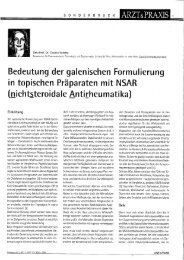Diclofenac Sodium 4% Spray Gel - cyathus.cz
Diclofenac Sodium 4% Spray Gel - cyathus.cz
Diclofenac Sodium 4% Spray Gel - cyathus.cz
Create successful ePaper yourself
Turn your PDF publications into a flip-book with our unique Google optimized e-Paper software.
PAR <strong>Diclofenac</strong> <strong>Sodium</strong> <strong>4%</strong> <strong>Spray</strong> <strong>Gel</strong><br />
UK/H/0562-3/001/E01<br />
COMPLIANCE WITH GUIDELINES<br />
The application complied with the guidelines available at the time of initial<br />
assessment by the UK Licensing Authority.<br />
CONCLUSION ON QUALITY<br />
The pharmaceutical assessor concluded that marketing authorisations may be granted<br />
for these products.<br />
III.2 PRE-CLINICAL ASPECTS<br />
PHARMACODYNAMICS<br />
The pharmacology of diclofenac sodium, an NSAID, is well established and has been<br />
adequately reviewed by the expert. <strong>Diclofenac</strong> sodium inhibits prostaglandin synthesis<br />
through inhibition of cyclo-oxygenase (COX). <strong>Diclofenac</strong> is a more potent inhibitor of<br />
COX-2 than COX-1 and has anti-inflammatory, analgesic and antipyretic activity. Some of<br />
the metabolites of diclofenac have anti-inflammatory activity but are less potent than<br />
diclofenac. 4′-Hydroxy-diclofenac, the major metabolite in man, has anti-inflammatory,<br />
analgesic and antipyretic activity but is 15-60 times less potent than diclofenac.<br />
In rat and hen models of osteo-arthritis, diclofenac sodium produced a dose-dependent antidegenerative<br />
effect indicating good cartilage tolerance of diclofenac.<br />
The expert has discussed the interaction of oral diclofenac with a number of medicines in<br />
several animal models.<br />
PHARMACOKINETICS<br />
After oral administration, diclofenac is rapidly absorbed and undergoes first pass metabolism.<br />
Systemic availability of unchanged diclofenac is 38% and 60% in dog and man, respectively.<br />
After the topical application of diclofenac solution and diclofenac aqueous gel containing<br />
0.25% phospholipid (not identical to DSG <strong>4%</strong>) to rats, plasma C max was reached within 4h and<br />
systemic availabilities were <strong>4%</strong> and 26%, respectively. Apparently, the phospholipid<br />
component increased penetration of diclofenac through the stratum corneum.<br />
The in vitro skin permeation (using abdominal skin from human volunteers) of DSG <strong>4%</strong> was<br />
compared with that of Voltaren ® Emulgel (1.16% diclofenac diethylammonium), and<br />
formulations containing 1, 2 or <strong>4%</strong> diclofenac sodium, using a modification of the method<br />
developed by Maibach and Reifenrath. Permeation of DSG <strong>4%</strong> into the receptor fluid<br />
occurred with a lag period of 80min. The maximum concentrations detected in the receptor<br />
fluid were 7.7µg/cm 2 and 0.43µg/cm 2 with DSG <strong>4%</strong> and Voltaren ® Emulgel, respectively.<br />
Within 8h, up to 2.5% of DSG <strong>4%</strong> was completely absorbed through the skin, as opposed to<br />
0.12% with Voltaren ® Emulgel. Permeation of deeper skin layers was more pronounced with<br />
DSG <strong>4%</strong> (36% of dose, 148µg/cm 2 ) than with Voltaren ® Emulgel (9% of dose, 34µg/cm 2 ). In<br />
contrast, diclofenac concentrations in the stratum corneum were higher with Voltaren ®<br />
Emulgel (78% of dose, 291µg/cm 2 ) than with DSG <strong>4%</strong> (47% of dose, 195µg/cm 2 ). Absorption<br />
from DSG <strong>4%</strong>, therefore, was about 21 times that of Voltaren ® Emulgel, and resulted in<br />
higher diclofenac concentrations in the deeper skin layers.<br />
Apparently a second in vitro skin permeation study showed that active ventilation of skin<br />
samples increased the penetration rate of DSG <strong>4%</strong> but not that of Voltaren ® Emulgel.<br />
21



